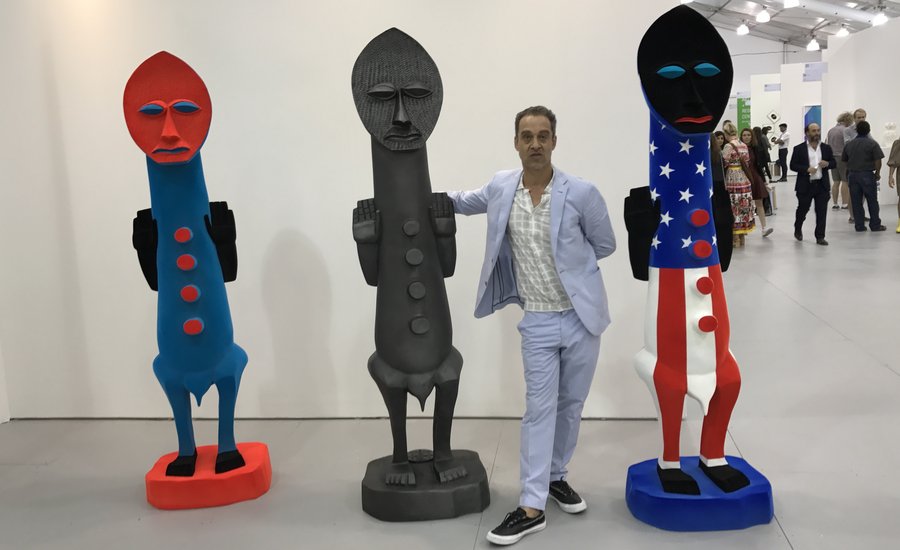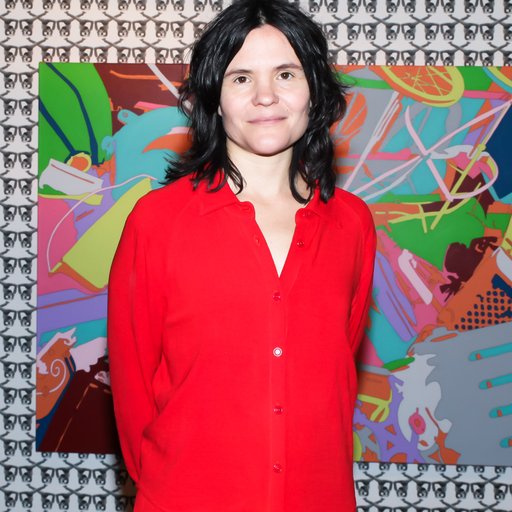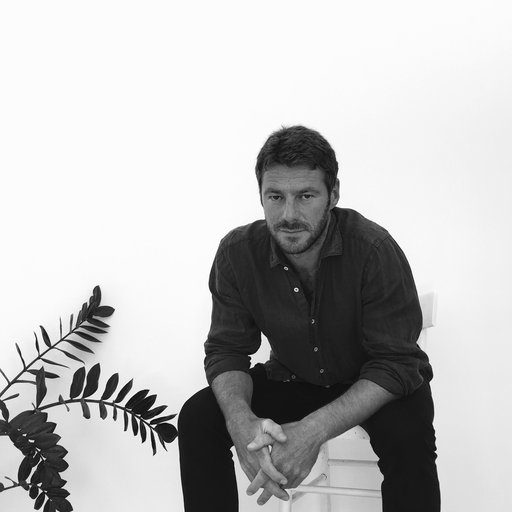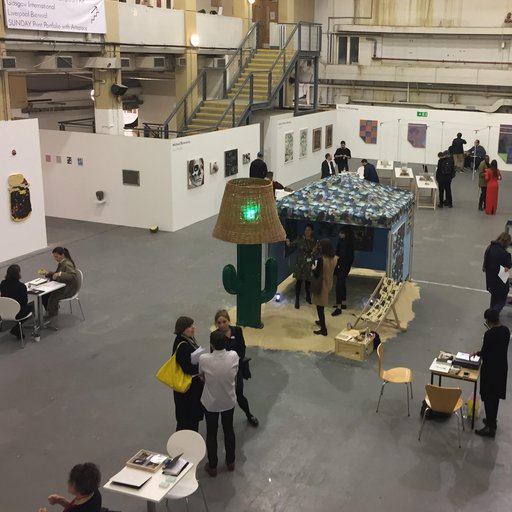Rippled by the ocean wind, the tent of the Untitled Art Fair is packed to the gills with artworks by up-and-coming artists, many of whom are just starting to get a toehold on success—and some of whom seem primed to become sensations. Here are 10 artists that collectors should get to know, fast.
GUÐMUNDUR THORODDSEN
Aysa Geisberg Gallery – New York
Works on paper $1,800-3,400, sculptures $800-2,200
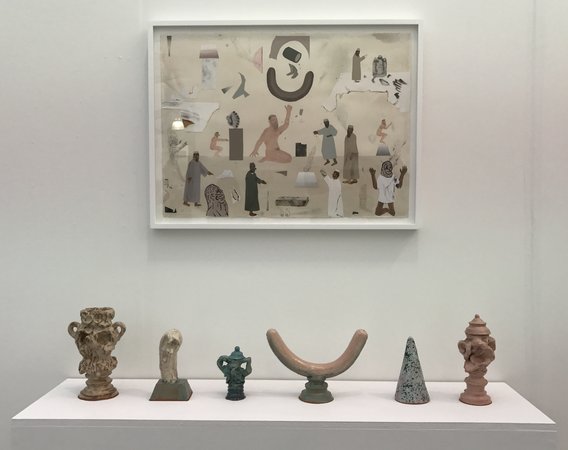

An Icelandic artist born and bred who lives in Reykjavik, Guðmundur Thoroddsen has spent the last decade making art that meditates on the crisis of masculinity in the modern era. Meditates, at least, in the manner of a 12-year-old boy—his collages and paintings are filled with (occasionally violent) figures smoking, farting, pooing, peeing, and otherwise indulging in infantile pleasures under the watchful eyes of ancient gods from the Middle East, who stand on the sidelines, stoic and adult. Thoroddsen’s particular gloss on the theme of puerile masculinity comes into even sharper relief in his ceramic sculptures, which function as awards for various feats, such as Trophy for Longest Pee, Trophy of Beards I, and—an especially rare and exalted one, when it comes to married men—Best Vacation Planner.
SIMON MULLAN
Dittrich & Schlechtriem – Berlin
$4,000-8,000

The Berlin-based artist Simon Mullan views art through the lens of handicraftsmanship, taking De Stijl notions of visual balance and rhythm and rendering them as a contractor would, in painstaking compositions of tile and grout. The painting-like things he makes from this process are enticingly minimalistic (and bathroom-friendly), and he has also been making similar works out of deconstructed bomber jackets—which he disassembles and then stitches into paintings—and also razor blades on sandpaper.

Lately, Mullan has been taking his approach to an architectural scale, covering the entire interior of galleries with his Mondrian-esque tiles, and for Untitled he spent two-and-a-half days with two laborers to build a pristine white wall that serves as one of the most elegant sights in the fair.
JUSTINE HILL
Denny Gallery – New York
$3,500-14,000

Inspired by the art of Elizabeth Murray and Frank Stella, the Brooklyn-based painter Justine Hill creates vibrant compositions of shaped canvases—the kind of décor-inclined, art-history-sampling work that Untitled excels at. What makes Hill a bit of an update on her aesthetic forebears is her careful, digitally enabled technique: she starts by making a drawing, then cuts sheets of plywood into shapes that match her sketch, then photographs the result so she can test out different painting strategies virtually before actually committing them to the brush. The results, which carry over the appealing cleanliness of their computerized process, have now won her a residency at MASS MoCA.
AARON FOWLER
Diane Rosenstein – Los Angeles
$7,500-9,000 for smaller pieces, $30,000 for the large piece

When the 28-year-old St. Louis-born artist Aaron Fowler was finishing his MFA at Yale two years ago, about to set off into an uncertain career in the art world, he began a body of work that cast himself in the role of a pilgrim venturing into the American frontier. As befits a Yale grad, these paintings were intensively researched, dipping back into the work of such 19th-century artists as Charles Marion Russell and Frederic Remington for images of settlers and their encounters with Native Americans—only replacing the settlers with his own African-American family.
Now these works, built from discarded materials he finds around his Brooklyn studio and then layered with digitally printed imagery, have become a sensation. The Rubells—who, according to Fowler’s dealer, Diane Rosenstein, consider him the “next great American artist”—have given him a large, impressive room in their newest group show, and ArtReview has likewise dubbed him a “future great.”
At the fair, Fowler has presented an important artistic document from his starry pilgrim’s progress: a large composition, based on treaty paintings that commemorate pacts between settlers and Native Americans, that relates the moment that Fowler decided to join Rosenstein’s gallery. (He wasn’t sure he wanted to work with one, and is still mulling over the traditional dealer-artist format.) On one side is Fowler, his family, and LeBron James (for good measure); on the other side, in the place of the Native Americans, is Rosenstein and her team.
ALINA KUNITSYNA
Galerie Lisa Kandlhofer – Vienna
$9,500 each


Op Art, by several market indicators, is having a comeback these days—just look at the renewed affection for Victor Vasarely. That makes it a ripe time for an artist like Alina Kunitsyna, whose optically beguiling paintings at the fair are so convincingly three-dimensional they require a 180-degree inspection just to make sure that your eye has been deceived. Identified by her Austrian dealers as a 42-year-old White Russian artist, Kunitsyna—who specializes in well-rendered trompe-l’oeil paintings of ridged fabric—made these geometric compositions specially for the fair, with the blue-tinted green echoing the colors of the ocean splashing outside the tent.
MATTHEW STONE
The Hole – New York
$7,500-20,000

The multitalented London-based artist Matthew Stone creates the soundtracks for Gareth Pugh’s fashion shows, designed an album cover for FKA Twigs, cofounded an art collective called !WOWOW! (with Hanna Hanra) in an abandoned Pekham department store, and writes manifestos about optimism in his spare time. His particular strain of optimism is also something he expresses through his delirious paintings of beautiful, nude, gender-morphing figures that look as if they were pulled from a Michelangelo fresco and zapped in some sort of multidimensional digital blender.

He makes these artworks by painting on a glass surface, which allows him to photograph both the top and bottom of the brushstrokes, then uploads them to his computer to sculpt those strokes into credibly three-dimensional bodies—which, in fact, are reminiscent of the notorious “Bodies” exhibition. Finally, using a high-tech printing facility in the Netherlands, Stone extrudes his images onto linen through multiple layers of a plasticky ink, which lends the paintings a kind of new-fangled impasto. When paintings from this body of work were recently shown at London’s Somerset House, on the anniversary of Thomas Moore’s Utopia, they sold out overnight.
ÉMILIE BROUT & MAXIME MARION
Steve Turner – Los Angeles
$1,600 for an iPhone, $8,000 for the planter


Based in Paris, the French artists Émilie Brout and Maxime Marion met in art school about a decade ago and since then have worked as a duo, making artworks that celebrate the confusion between the digital and the physical. One charming piece at Steve Turner’s booth, for instance, consists of a green chunk of OASIS Maxlife foam—a substance florists use to secure and nourish flower arrangements—that the artists have “planted” with several smartphones and tablets playing a forrest of plant gifs they culled from the internet. Featuring dozens of mostly amateur looped animations of plants from Super Mario, Pokémon, and other sources, the piece charts “20 years of gif history,” according to the artists.

Another body of work, on a nearby wall, is composed of broken-screened phones that the artists buy at second-hand stores and then program with animations that play between the cracks, harmonizing with the damage—an update of kintsugi, the Japanese tradition of repairing broken porcelain with gold-dusted lacquer. Discovered by the gallery at Art Brussels, the artists will now have a solo show in Turner’s L.A. project room.
JOSÉ LERMA & JOSH REAMES
Luis de Jesus – Los Angeles
Around $100,000

When the two friends José Lerma and Josh Reams, both rising-star painters, were given the opportunity to collaborate on two giant triptychs at Luis de Jesus gallery, they agreed on one ground rule: because they have such different sensibilities when it comes to color, it would have to be in black and white. That out of the way, they had another quandary: what should they paint? They thought about it, mulling over who would be the target audience for such gigantic artworks, then decided they would have to be hugely wealthy collectors with sprawling houses. So, what do hugely wealthy collectors like? Offshore tax shelters in the Caiman Islands!
Thus equipped, the two worked in tandem to paint massive scenes from the annual Pirates Week festivities, when Caiman Islanders fête their buccaneering lineage with a big island-wide party. Lerma and Reames bounced back and forth between the canvases, Lerma painting several noted collectors and advisors sitting around a table topped by a lion, Reames painting gym socks on the lion; on top of the scene, with cannon balls wooshing across and pirates marauding everywhere, they painted the hand of god, descending from the heavens to anoint the system. Well, it seems the system wants to anoint the painting, too: several major collectors and museum trustees expressed interest in the piece at the fair on the opening day.
TEPPEI KANEUJI
Jane Lombard Gallery – New York
$1,650-27,000


A Japanese artist in his late 30s who lives in Kyoto, Teppei Kaneuji makes playful drawings about mass-consumer culture, prints the drawings on cloth, then stuffs the cloth to create little pillows. The fun, humbly ingenious works that result have a bit of satirical bite, as do the “toys” he builds out of plastic containers, cooking utensils, and other odds and ends and then coats in gloopy resin. His solo booth with Jane Lombard Gallery had the feeling of a cool, jaded toddler’s rumpus room.
ZAK OVÉ
Modern Forms – London
Not for sale (but if it was, $19,000-35,000, according to Vigo Gallery)

The son of Horace Ové, one of Britain’s first black filmmakers and the documentarian behind the indispensable film Baldwin’s Nigger (watchable on YouTube), Zak Ové uses art to explore the disconnect between the ancient artifacts of his ancestral Trinidad and Africa and contemporary art. “When looking at African sculpture we often think of something created in a village, a relic, not something that was once contemporary,” he said at the fair. “So, how can we carry that tradition into the future?”
One of his answers to that question can be seen at the fair in three large totems at the noncommercial booth of Hussam Otaibi’s Modern Forms collection, one of which he made out of graphite (a substance Ové considers “very futureworld") and two of which he crafted from acrylic fiber, which yields an impressive pop of color—both being materials a world away from the ebony wood traditionally used. The graphite sculpture, it should be said, was one of 40 that were presented in the courtyard of London’s Somerset house at the last 1:54 Contemporary African Art Fair, where they were counted as one of that fair’s standout inclusions as well.
[related-works-module]











